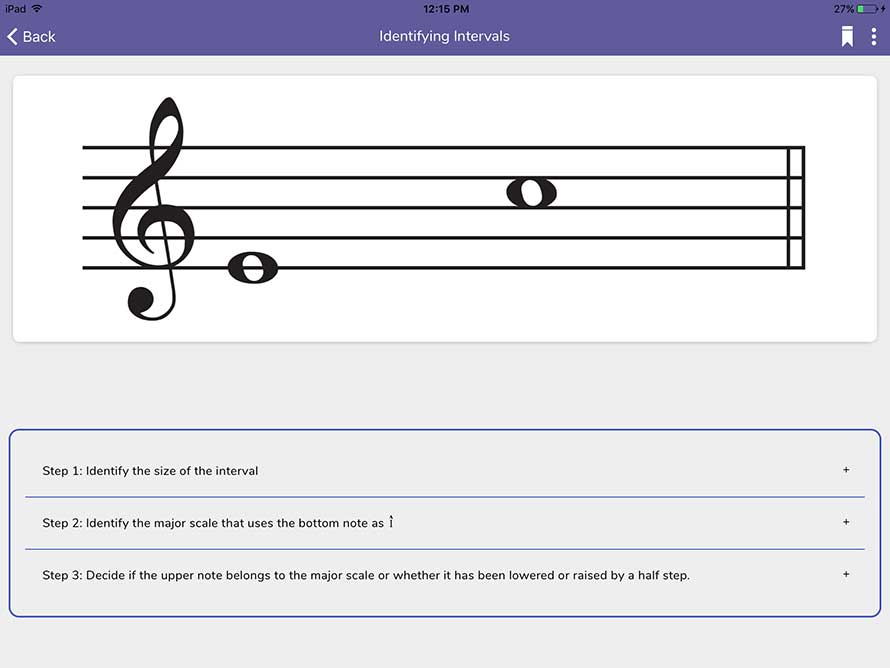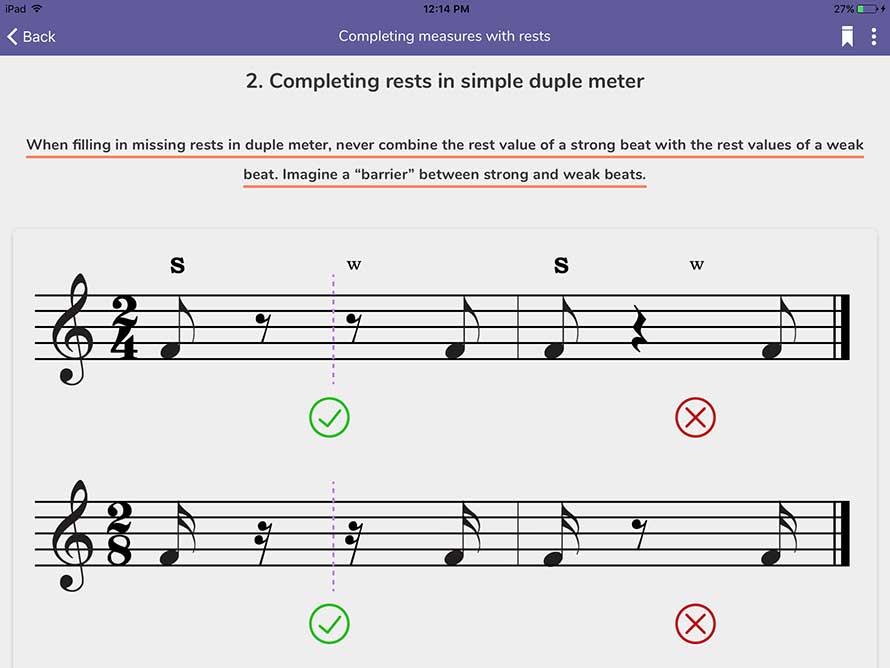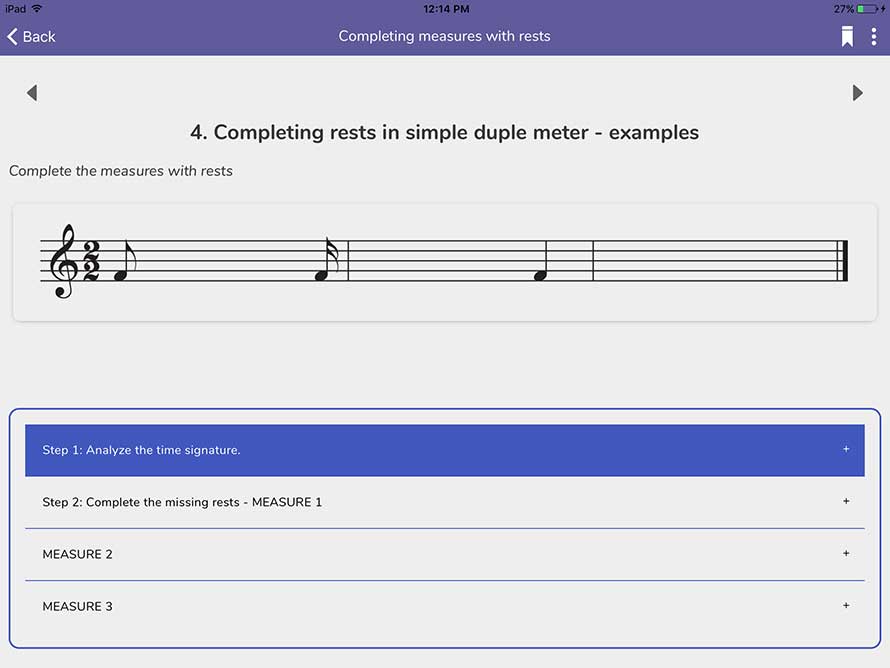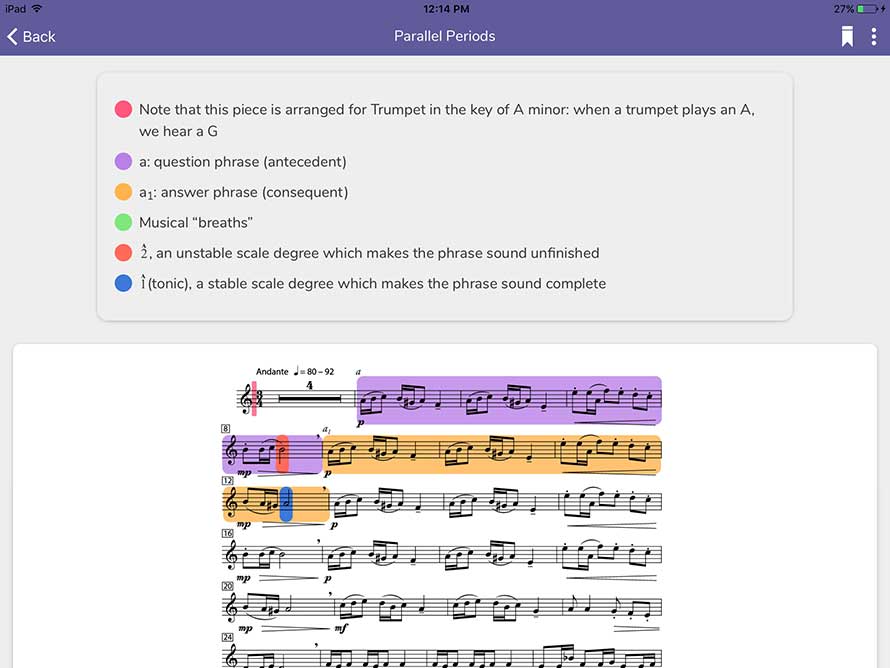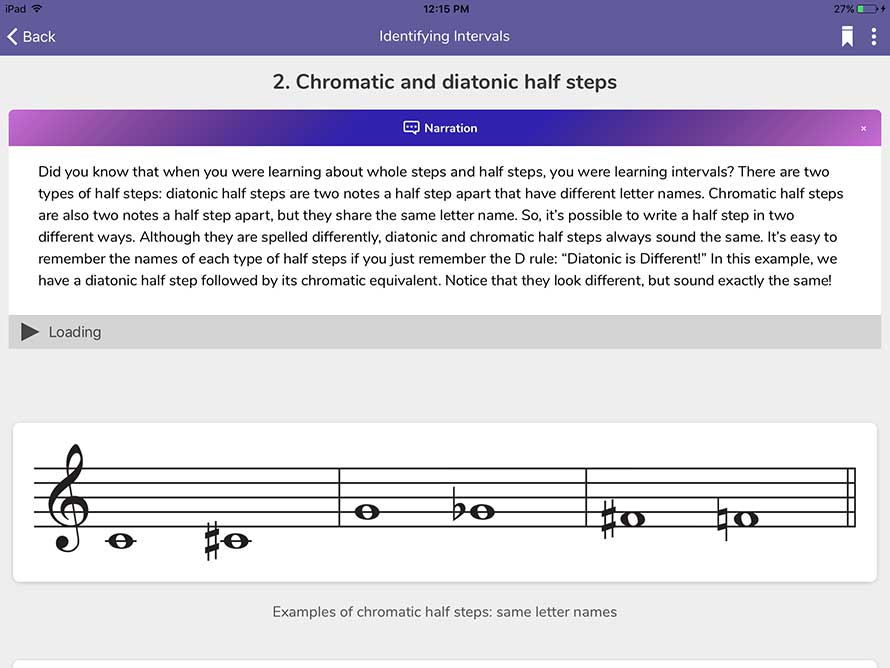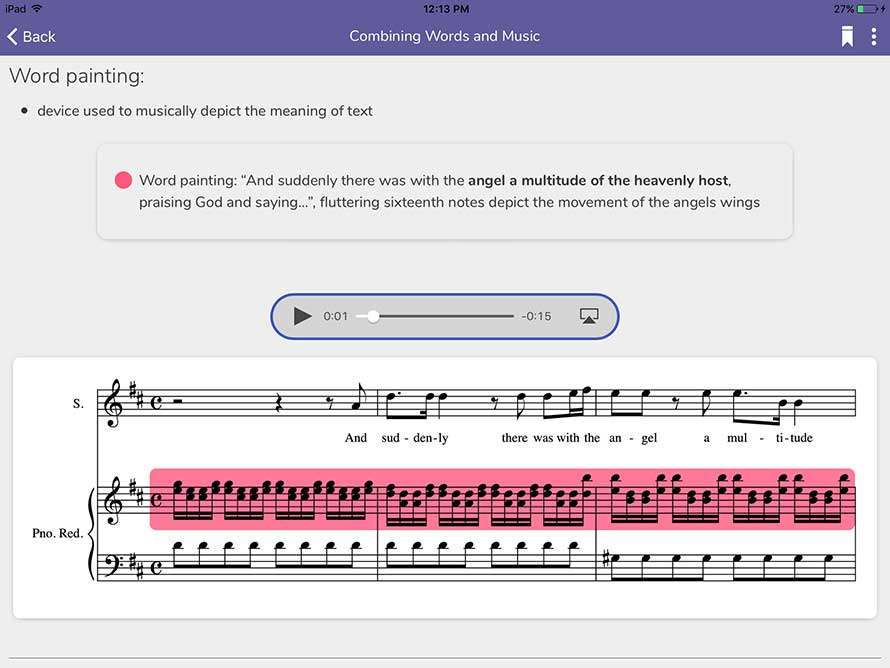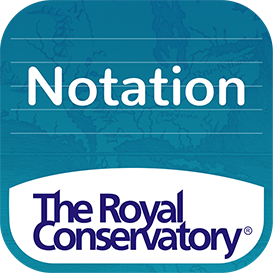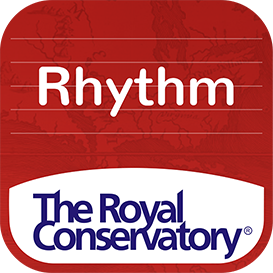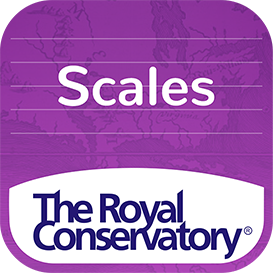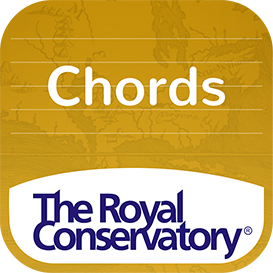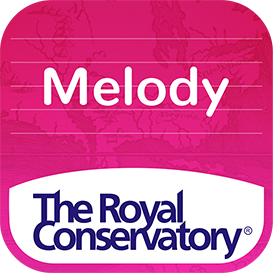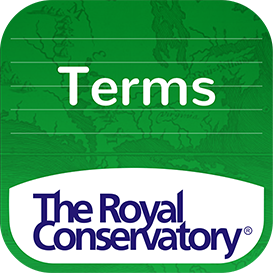Four Levels for Intermediate Theory Students
Available for Purchase
Each Course Contains 8 Units

Pitch, Notation and Transposition

Rhythm and Meter

Scales and Key Signatures

Intervals

Chords and Harmony

Melody Writing, Form and Analysis

Music History

Musical Terms and Signs
Completing courses on an iPad is recommended to ensure a seamless learning experience, and allow students to download Practice Apps designed to integrate with the content and learning at each level of study.
Learn at Your Own Pace, Anytime, Anywhere!
Take Tests and Exams When You’re Ready.

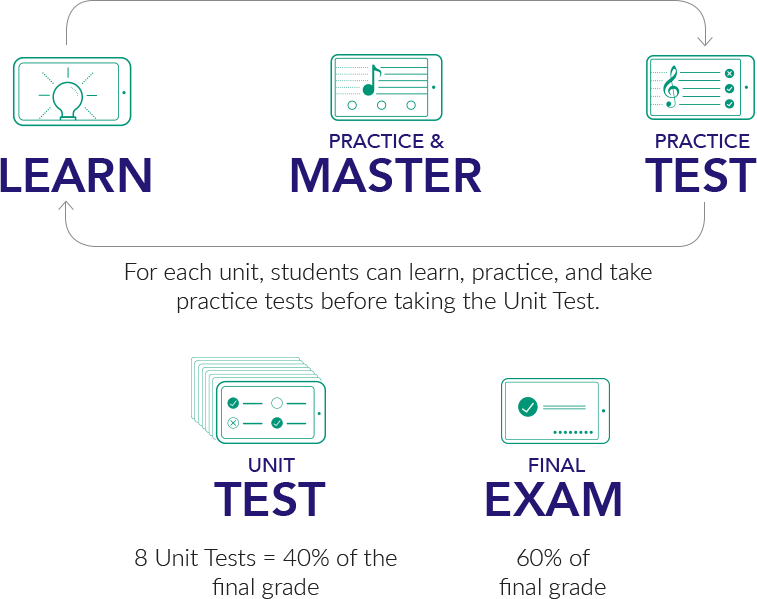
Each Course Contains
- Unlimited Practice Tests
- Eight Unit Tests
- One Final Exam
Practice Tests can be completed as many times a student wishes before taking the Unit Test. Unit Tests can only be completed once and cumulatively represent 40% of a student’s final grade. After all Unit Tests have been completed, the student can take the Final Exam which will represent the remaining 60% of the final grade.
Best of all, no more waiting for an examination session or traveling to an exam center. Students can take the Unit Tests and Final Exam when they’re ready, from a comfortable home environment!
Course Features
- More than 50 narrated lessons
- 8 units of study covering essential concepts including theory, scales, melody writing, and history
- Hundreds of embedded audio examples
- Interactive exercises with instant feedback for every learning objective
- Flexibility to progress through units in any order
- Offline lessons for anywhere learning
- Embedded Unit Tests and Final Exam
- Unlimited access to practice tests to help prepare for Unit Tests and Final Exam
Course Outlines
To fully prepare students for taking the Unit Tests and Final Exam, each concept covered in the course begins with a mission and ends with an invitation to practice concepts in our RCM Music Theory Apps.
Unit 1: Pitch and NotationLedger Lines and Enharmonic Equivalents
- Why use ledger lines?
- Ledger lines
- Enharmonic equivalents
- Transposing down an octave
- Transposing up an octave
- Rewriting, not transposing!
- Transposing a melody
- Rewriting a melody
Note and Rest Values
- Note and rest values review
- Breves and semibreves
- Breves and semibreves example
- Dotted whole note and example
- Triplet sixteen notes and triplet quarter notes
- Triplet sixteenth note example
- Triplet quarter note example
- New notes and rests review
- Simple duple, triple, and quadruple meter review
- Introducing 2/2, 3/2 and 4/2
- 2/2 example
- 3/2 example
- 4/2 example
- Compound Time Signature 6/8
- Compound Duple Time
- Identifying a time signature - examples
- Summary – Time Signatures and Meter
- Completing rests in simple duple meter
- Completing single beats with rests
- Completing rests in simple duple meter - examples
- Completing rests in simple quadruple meter
- Completing rests in simple quadruple meter - examples
- Completing rests in simple triple meter
- Completing rests in simple triple meter - examples
- Completing rests in compound duple meter
- Completing rests in simple triple meter - examples
Major and minor scales with 4 sharps or flats
- E major and A flat major
- Major scale pattern
- Major scales
- C sharp minor and A flat minor
- Minor scale patterns
- Minor scales
- Relative keys
- Finding the relative minor key of a major key
- Parallel keys
- Scale degree names – tonic, subdominant, dominant, subtonic, leading tone
Identifying Intervals
- Chromatic and diatonic half steps
- Diatonic and Chromatic Half Steps example
- Intervals: quality and size
- Major, minor and perfect intervals
- Identify the interval – examples
- Writing an interval – examples
Primary Triads and Dominant Sevenths
- Triads
- Quality of primary triads in major and minor scales
- Dominant 7th chords
- Identifying dominant 7th chords
- Writing dominant 7th chords
- Functional chord symbols
- Root/quality chord symbols
- Inversions of triads
- Identifying triad inversions –examples
- Writing inversions of primary triads –examples
Identifying the key of a piece
- Identify a key as major or minor by listening
- Identify a key as major or minor by looking for clues
- Steps for identifying the key of a melody
- Musical ideas
- Parallel periods
- Analyzing phrases
- Parallel periods – examples
- Composing an answer phrase
Combining words and music
- Messiah by Handel
- Oratorios, choruses and word painting
- Hallelujah chorus analysis
- Operas and Arias
- The Magic Flute by Mozart
- “Queen of the Night Aria”
- Analysis of the aria - part 1
- Analysis of the aria - part 2
- The Wizard of Oz by Harold Arlen
- Analysis
- Andantino
- Cut time, 2/2
- espressivo, espress.
- larghetto
- largo
- leggiero
- pedale, ped.
- rubato
- spiritoso
- tranquillo
To fully prepare students for taking the Unit Tests and Final Exam, each concept covered in the course begins with a mission and ends with an invitation to practice concepts in our RCM Music Theory Practice Apps.
Unit 1: Pitch and NotationTransposition in major keys up by an interval
- Changing the key of a melody
- Transposing up to a key
- Handling chromatic notes when transposing
- Transposing up to an interval
Note and Rest Values
- Thirty second notes and rests
- Thirty second notes and rests - example
- Dotted sixteenth notes and rests
- Dotted sixteenth notes and rests - example
- Compound duple, triple and quadruple meter
- Compound duple meter example
- Compound triple meter example
- Compound quadruple meter example
- Identifying a time signature - examples
- Summary – Time Signatures and Meter
- Completing rests in compound meters
- Completing single beats with rests
- Completing rests in simple triple meter - examples
Major and minor scales with 5 sharps or flats
- C flat/B major and A flat/G sharp minor
- C flat/B major and A flat/G sharp minor
- C flat/B major and A flat/G sharp minor
- Review of all major scales
- Review of all minor scales
- Scale degree names - tonic, supertonic, median, subdominant, dominant, submediant, subtonic, leading tone
Identifying Intervals
- Double sharps and double flats
- Double sharps and double flats - example
- Augmented and diminished intervals
- Augmented and diminished intervals summary
- Importance of letter name in augmented and diminished intervals
- Identifying a chromatically altered interval - examples
- Chromatically altered intervals summary
- Writing a chromatically altered interval
- Identifying intervals when the bottom note is not the tonic of a major key
- Different ways of altering intervals
- Identifying a chromatically altered interval when the bottom note is not the tonic of a major key - examples
- Writing a chromatically altered interval when the bottom note is not the tonic of a major key
New triads and open and closed positions of chords
- Supertonic, median, and sub-mediant triads
- Triad inversion review
- Triads in open or closed position
- Dominant 7th chords in open or closed position
- Authentic cadence (V-I)
- Authentic cadence (V-i)
- Half cadence (I-V)
- Half cadence (i-V)
- Half cadence (IV-V)
- Half cadence (iv-V)
- Composition example
- Cadences and harmony
- Keyboard style cadences
- Identifying cadences
Key of a melody and phrase composition
- Identifying the key of a melody with a key signature
- Identifying the key of a melody without a key signature
- Identifying the key of a melody without a key signature
- Composing phrases
Combining words and music
- Johann Sebastian Bach
- Invention in C major
- “Brandenburg Concertos”
- Brandenburg Concerto No. 5, first movement
- Wolfgang Amadeus Mozart and Eine kleine Nachtmusic
- Sonata form
- ad libitum, ad lib.
- alla, all’
- ben, bene
- col, coll’, colla, colle
- con
- con brio
- con espressione
- con fuoco
- con grazia
- con moto
- e, ed
- fortepiano
- grave
- loco
- ma
- meno
- meno mosso
- non
- più
- più mosso
- poco a poco
- primo, prima
- quasi
- secondo, seconda
- sempre
- senza
- sforzando
- simile
- subito
- tre corde
- troppo
- una corda
To fully prepare students for taking the Unit Tests and Final Exam, each concept covered in the course begins with a mission and ends with an invitation to practice concepts in our RCM Music Theory Practice Apps.
Unit 1: Notation and TranspositionTransposition down to another key or down an interval
- Review: transposing up to another key
- Review: transposing up by interval
- Transposing down to another key
- Transposing down by interval
Double dotted notes and rests and irregular groupings
- Double-dotted notes
- Double-dotted notes - example
- Double-dotted rests
- Irregular groupings
- Irregular groupings - examples
Chromatic, Whole-Tone, Octatonic, Pentatonic and Blues scales
- Chromatic scales starting on C, F Sharp and G flat
- Chromatic scale – example
- Whole-tone scales
- Octatonic scales
- Pentatonic scales
- Pentatonic scales – example
- The Blues scales
- The Blues scales – example
Identifying Intervals
- Diatonic and chromatic intervals
- Writing intervals below a note
- Inverting intervals
- Inverted intervals – example
Chords
- Augmented and diminished triads
- Functional chord symbols and root quality symbols
- Leading tone diminished 7th
- Identifying seventh chords in open position
- Inversions of augmented and diminished triads
- Functional chord symbols and inversions
- Dominant 7th chords and inversions
- Review of half cadences, authentic cadences and keyboard style
- Authentic cadence in G minor
- Half cadence (I-V)
- Half cadence (i-V)
- Cadences at phrase endings – examples
Key of a melody and composing contrasting periods
- Passing tones – example
- Neighbor tones – example
- Writing a contrasting periods
- Harmonic progressions – examples
Musical Styles of the Romantic and Modern Eras
- Felix Mendelssohn
- Overture to a Midsummer Night’s Dream and Sonata form
- Frédéric Chopin
- Etude in C Minor (“Revolutionary”)
- Igor Stravinsky
- Petrushka and Rondo form
- Hugh LeCaine
- Dripsody
- Duke Ellington
- Ko-Ko
- agitato
- dolente
- giocoso
- grandioso
- martellato
- mesto
- morendo
- pesante
- quindicesima alta, 15ma
- risoluto
- scherzando
- semplice
- sonore
- sopra
- sostenuto
- sotto voce
- tacet
- tutti
- vivo
- volta
- volti subito, v.s.
To fully prepare students for taking the Unit Tests and Final Exam, each concept covered in the course begins with a mission and ends with an invitation to practice concepts in our RCM Music Theory Practice Apps.
Unit 1: Notation and TranspositionTransposition in major keys up by an interval
- C clef
- Moveable C clef
- Alto clef
- Tenor clef
- Arranging key signatures
- Transposition between clefs
- Transposing instruments
- Vocal scores
- String quartets
Hybrid meters
- 5/8 example
- 5/4 example
- Mixed meters – examples
- Hybrid duple, triple, and quadruple meter
- completing measures with rests in hybrid meters
Scales in context and diatonic modes
- Scale passages - examples
- Modes
- Writing modes
Identifying Intervals
- Compound intervals
- Inverting intervals
- Triads on major, natural minor and harmonic minor scales
- Review of functional chord symbols and inversions
- Review of dominant 7th chords and inversions
- Root/quality chord symbols and inversions
- Plagal cadences in keyboard style
- Cadences in chorale style
- Writing cadences at phrase endings – example
Melody writing in minor keys
- Review of contrasting periods in a major key
- Contrasting periods in a minor key
- Harmonic rhythm – examples
- Harmonic progressions – examples
- Melodic motion
- Expanding harmonic vocabulary
Medieval era, Renaissance era, and world music
- Hildegard von Bingen
- Ordo Virtutum, Scene 4
- Sumer is Icumen In
- Josquin des Prez
- El grillo
- Javanese Gamelan
- Raga in Indian Music
French Terms
- cédez
- léger
- lentement
- modéré
- movement
- vite
- bewegt
- langsam
- mässig
- mit Ausdruck
- schnell
- sehr
- allargando, allarg.
- arco
- attacca
- calando
- comodo
- con sordino
- largamente
- l’istesso tempo
- pizzicato
- ritenuto, riten.
- stringendo
NOTE:
We strongly recommend that the final online exam be proctored to ensure that RCM Online Theory Exams can be considered for secondary school credit the future. We are in process of establishing a proctoring process. Learn more here.
Course and Exam
Special introductory pricing starting at $379
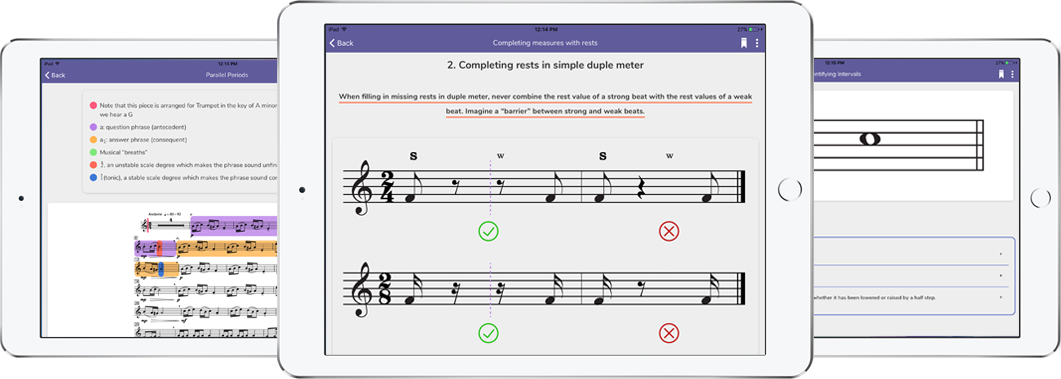
Have an RCM Account? Log in to your account before purchasing.
Terms & Conditions Online Exam Info
Master the Concepts with RCM Music Theory Apps
The best way to master Theory concepts. Exclusively available for iPad, download each of the 8 apps and purchase your level on the App Store. Designed to complement each level of RCM Music Theory Online Courses, these apps are invaluable resources for students preparing for RCM Theory Examinations.
The apps may also serve as standalone resources to help students sharpen their skills and gain confidence in the application of their knowledge.
RCM Music Theory Apps are not a required resource for RCM Music Theory Online courses, but are highly recommended to enhance the learning experience and ensure online exam success!

